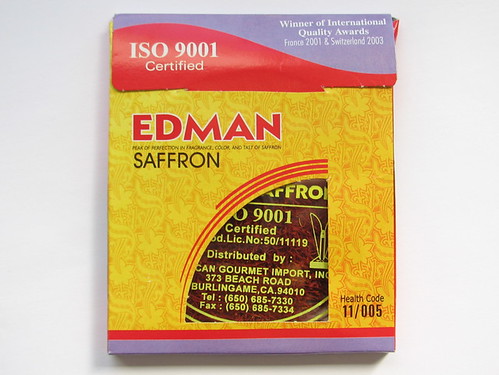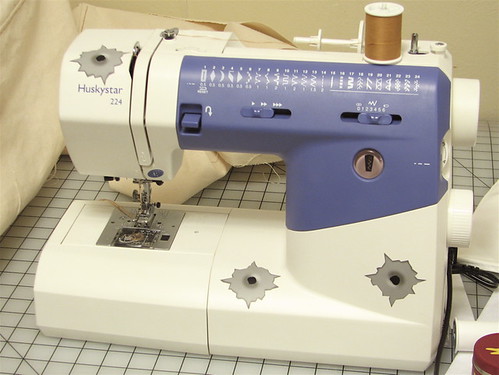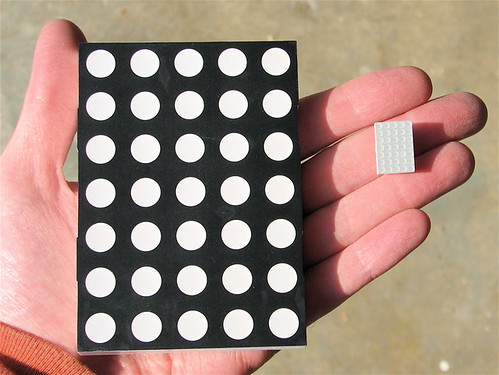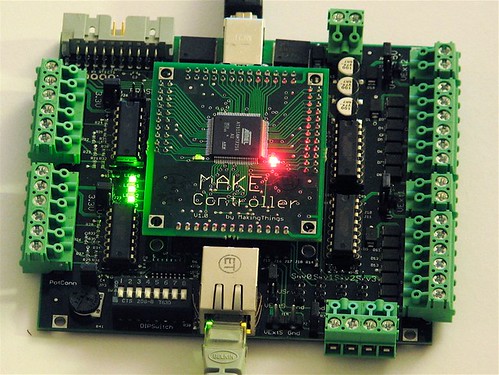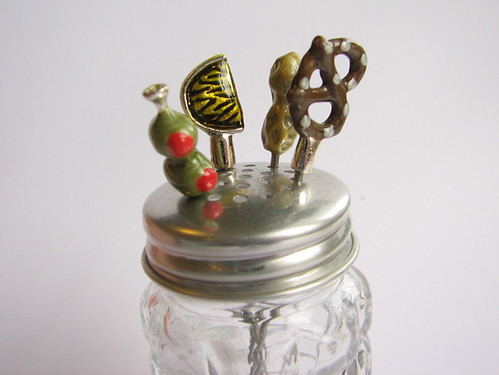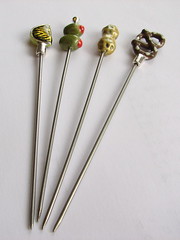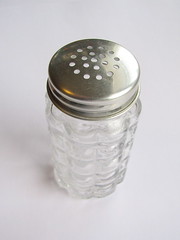
A few weeks ago, we made these chocolate truffles for a party. Boxes and boxes and boxes of them were eaten, but it’s truly remarkable how few people stopped to read the fine print.
Sneak preview: The Evil Mad Scientist 3D Printer Project
Did you enjoy making sugar cube sculptures as a kid? Boy have we got a project for you.
Besides the projects that we post here each week, we’ve been working on some larger scale projects in the past year. One of these is almost done, and we’re ready to give you a sneak preview: It’s a home-built, DIY, CNC, 3D printer, that uses granulated sugar as the printing medium. This is still a work in progress, but we’re making rapid progress and we hope to show off the completed printer at the Bay Area Maker Faire in May.
(Update added 5/9/2007: we’ve got it working now.)
The printable volume is 24 x 13.5 x 9 inches, with programmed resolution of 1000 steps per axis. We expect effective pixel size to be in the range of 2-5 mm. In other words, it makes fairly large, but fairly low resolution, models out of sugar. Think of it as a way to make giant and amazing sugar cube sculptures!
Continue reading Sneak preview: The Evil Mad Scientist 3D Printer Project
Ball Bushing Box Matryoshka
We shop regularly at Weird Stuff since it is right down the street from us. We get all kinds of goodies; mostly parts for projects, but also the occasional computer or flower pot. We had a very successful shopping trip recently, and came home with a set of Russian stacking dolls (a.k.a. matryoshka, plural: matryoshki). 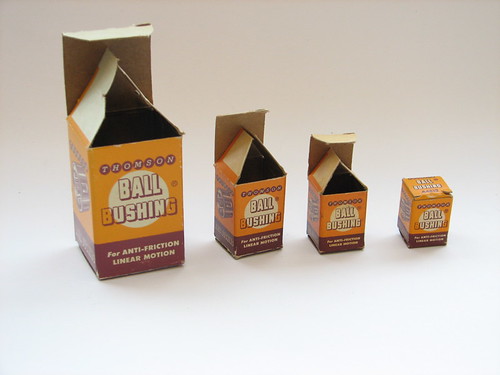
Our matryoshki are in the form of a matched set of American bushing boxes in graduated sizes. They stack together beautifully, making a nesting toy of the best kind.
Continue reading Ball Bushing Box Matryoshka
Quick and Dirty D to A on the AVR: A timer tutorial
 So you’ve got a microcontroller and you want to use it to control something analog. That’s a common task, and a number of good solutions exist, depending on exactly what you need to do.
So you’ve got a microcontroller and you want to use it to control something analog. That’s a common task, and a number of good solutions exist, depending on exactly what you need to do.
Most microcontrollers do not include built-in digital-to-analog conversion (DAC) hardware, and external converters cost money. There is, however, a quick, easy, and cheap little trick of a solution that can be played by averaging a digital output.
This is a short tutorial on making useful (but crude) analog output signals with a low-cost microcontroller. The analog signals will be made by averaging a digital pulse width modulation (PWM) output from one of the counter/timer units in the microcontroller, and do not require any dedicated digital to analog conversion hardware. We will first introduce some aspects of the counter/timer and discuss how it can be used to generate the pulse width modulation signal. After that, we’ll implement the scheme on an AVR microcontroller and use it to make a simple and slow little function generator circuit.
Continue reading Quick and Dirty D to A on the AVR: A timer tutorial
My Saffron
One of the fabulous things about living in the San Francisco Bay area is the grocery shopping. There are stores catering to the cooking styles of so many cultures and we have access to all of them. We have our favorite Japanese, Asian, Indian, Middle Eastern and Mediterranean stores. We went to one of our favorite markets, Caron International Food Market, to get Bulgarian feta, kalamatas and saffron. They keep the saffron behind the counter, with good reason. The stuff runs $500 to $5000 per pound. Last time we got some there it was a decent price, so we asked the super friendly shopkeepers for some more. Lo and behold, they pulled out a package with my name on it. Literally, my name: the package says “Edman Saffron” and my last name is Edman. How cool is that?
Keep reading for more about saffron.
Continue reading My Saffron
Bullet hole stickers
These great bullet-hole stickers cost $5.99 for a 20-pack at stickergiant. I like to put them on almost everything. In this case, Lenore’s sewing machine.
LED Matrix Displays
Mike Kash, my physics professor at Lake Forest College, once said that he liked matrices “so much that I sleep on one.” The two
5×7 LED matrix displays shown here have pointy plastic edges and are probably not very comfortable to sleep on.
These displays are both alike in character, with the same potential to display thirty five beautiful and well-resolved pixels of bitmappy goodness. That’s just the thing for the new video standard that I’m proposing: Widescreen Ultra Low Defintion, or WULD for short. (HDTV is for wimps. 128-bit video may spark a format war with WULD, but widescreen it is not.)
It is fun to contrast the remarkably different sizes of these two displays. The one on the left is from a large readerboard, and is four inches tall with 10 mm green LEDs. The dots are almost as big as the entire miniature version, shown on the right with its 3 mm red LEDs. More common than either of these sizes are the two-inch 5×7 displays that populate the readerboards sold at office supply stores.
LabVIEW routines for the MAKE Controller
As evidenced by a growing collection of projects, the MAKE Controller has great potential as a hardware platform enabling computers to really do things.
We won a MAKE Controller for our set of Halloween projects this year, and we’re just starting to play around with it. Having spent some pondering how best to communicate with the board, it’s clear that one of the barriers to more widespread use of this and other embedded systems is the lack, or perceived lack at least, of user-friendly software for programming and communication.
A number of open-source software packages, such as processing and Ruby, can communicate with the MAKE Controller using its OSC interface. However, there has been a noticeable absence of a suitable interface to LabVIEW, a program that is commonly used for interfacing to other similar types of hardware.
So, we wrote one. It’s a simple LabVIEW “vi” routine for issuing (most) simple commands and queries to the MAKE controller. We’ve also included some example routines to help you get your blinky lights going a few minutes sooner.
Continue reading LabVIEW routines for the MAKE Controller
Futility pole
Cocktail pick storage
I received a fun holiday present – a set of metal cocktail picks. They are very pointy, which I like, but this very feature raised a dilemma: where to put the darned things?! In a drawer is no good – you’ll get poked when you reach for the pastry brush.
I looked around the kitchen (a good way to get ideas) and my eyes lit on the salt shaker. Perfect! Food snobs that we are, our pepper lives in a grinder, not in a shaker. That meant there had to be an extra shaker somewhere, and (miraculously enough) I managed to locate it. The picks dropped right into the holes – clearly it was designed for this very purpose.
Continue reading Cocktail pick storage





